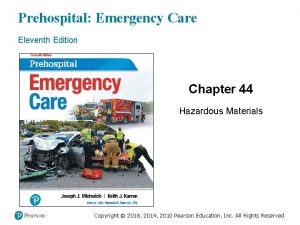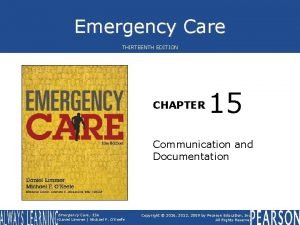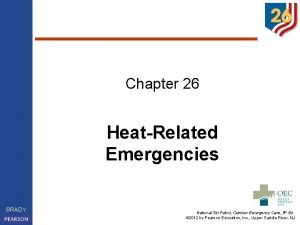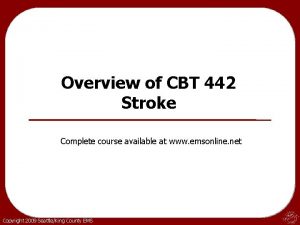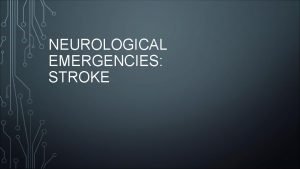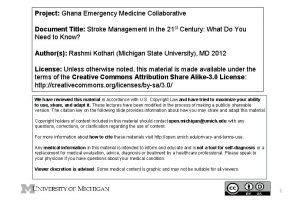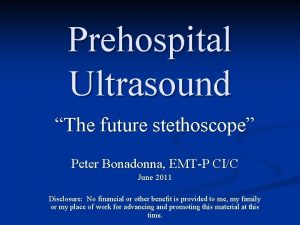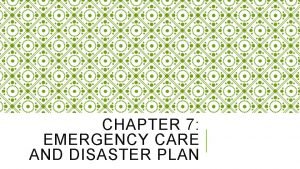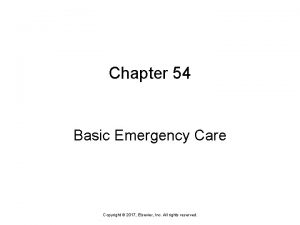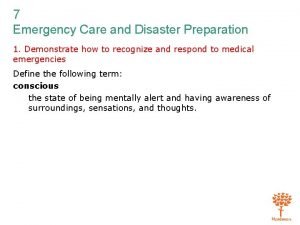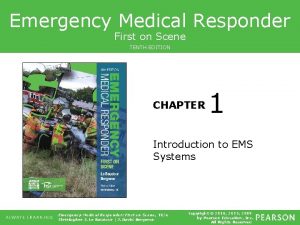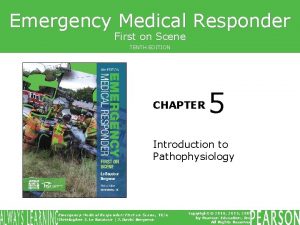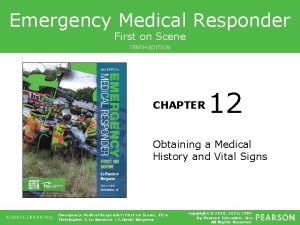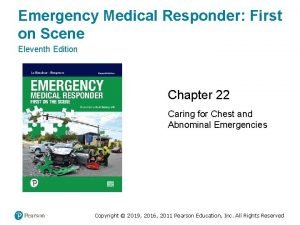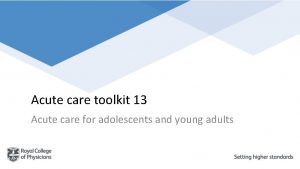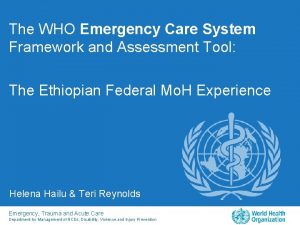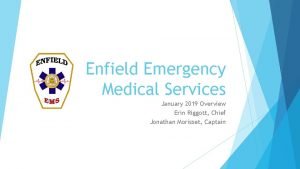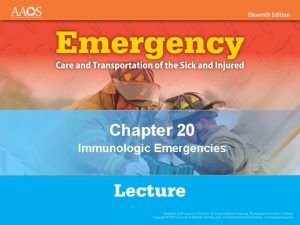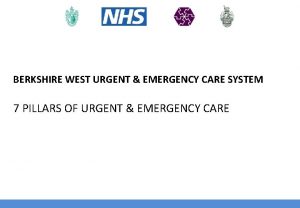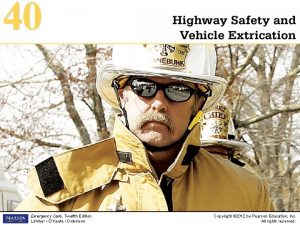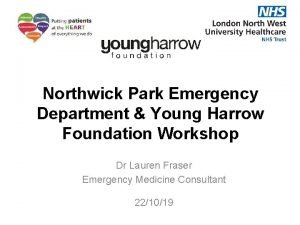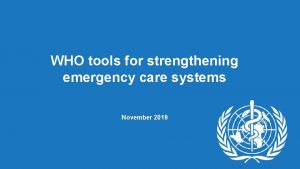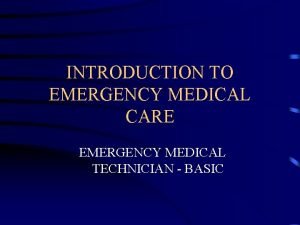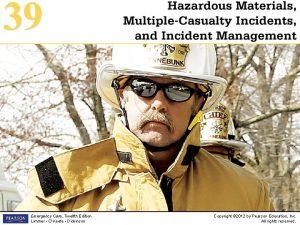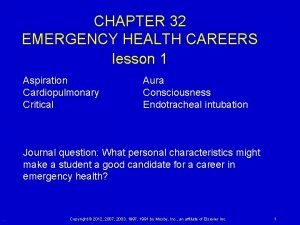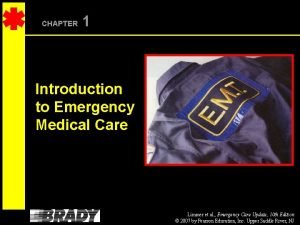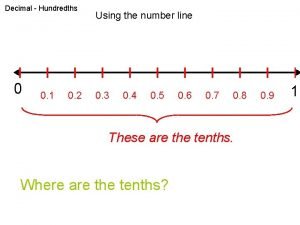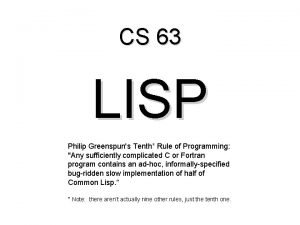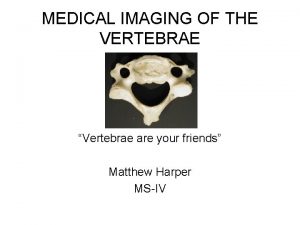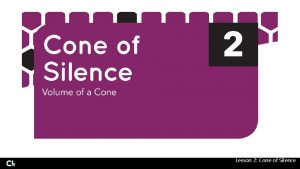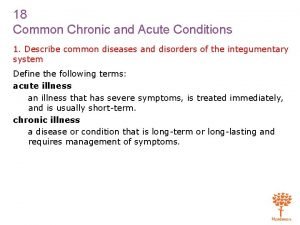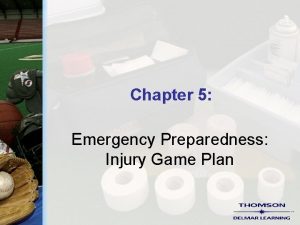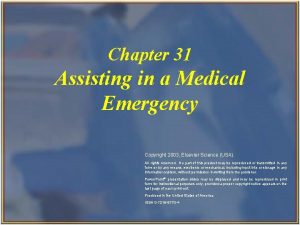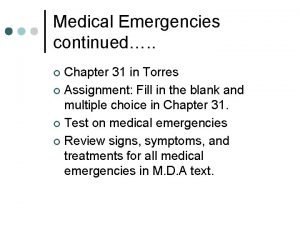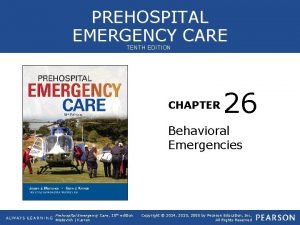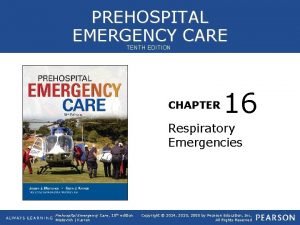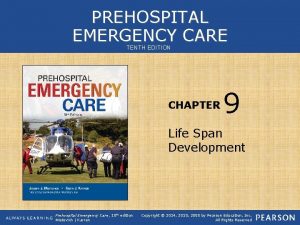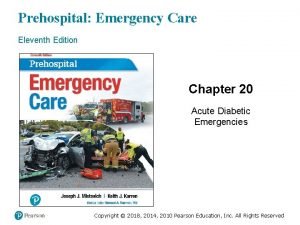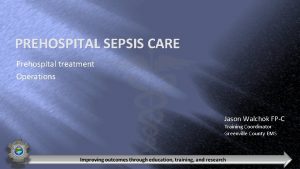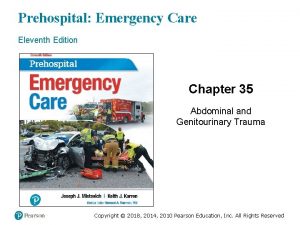PREHOSPITAL EMERGENCY CARE TENTH EDITION CHAPTER 20 Acute













































































- Slides: 77

PREHOSPITAL EMERGENCY CARE TENTH EDITION CHAPTER 20 Acute Diabetic Emergencies Prehospital Emergency Care, 10 th edition Mistovich | Karren Copyright © 2014, 2010, 2008 by Pearson Education, Inc. All Rights Reserved

Setting the Stage • Overview of Lesson Topics § Understanding Diabetes Mellitus § Acute Diabetic Emergencies § Assessment-Based Approach: Altered Mental Status in a Diabetic Emergency Prehospital Emergency Care, 10 th edition Mistovich | Karren Copyright © 2014, 2010, 2008 by Pearson Education, Inc. All Rights Reserved

Case Study Introduction EMTs Heidi Burr and JD Hudson arrive at the scene of a reported diabetic emergency to find a man in his 20 s sitting in the reception area of an office building, with two coworkers tending to him. The patient seems confused, and appears pale and sweaty. One of the coworkers says, "He was fine this morning, but he started acting strangely about 10 minutes ago. " Prehospital Emergency Care, 10 th edition Mistovich | Karren Copyright © 2014, 2010, 2008 by Pearson Education, Inc. All Rights Reserved

Case Study • What diabetic emergency seems likely, based on the information so far? • What information would you need to confirm your hypothesis? Prehospital Emergency Care, 10 th edition Mistovich | Karren Copyright © 2014, 2010, 2008 by Pearson Education, Inc. All Rights Reserved

Understanding Diabetes Mellitus • Under normal circumstances, hormones control the blood glucose level. • Diabetic emergencies result from abnormalities in blood glucose control. continued on next slide Prehospital Emergency Care, 10 th edition Mistovich | Karren Copyright © 2014, 2010, 2008 by Pearson Education, Inc. All Rights Reserved

Understanding Diabetes Mellitus • Glucose § Carbohydrates are the primary energy source for cells. § Complex carbohydrates are broken down into simple sugars, primarily glucose, for use by the cells. continued on next slide Prehospital Emergency Care, 10 th edition Mistovich | Karren Copyright © 2014, 2010, 2008 by Pearson Education, Inc. All Rights Reserved

Understanding Diabetes Mellitus • Glucose § Regulation of blood glucose level is critical to normal cell function. § Brain cells can only use glucose for energy, and cannot function when glucose is inadequate. § Low blood glucose results in altered mental status. § Prolonged low blood glucose leads to brain cell death. continued on next slide Prehospital Emergency Care, 10 th edition Mistovich | Karren Copyright © 2014, 2010, 2008 by Pearson Education, Inc. All Rights Reserved

Understanding Diabetes Mellitus • Glucose § Excess glucose in cells causes water to enter the cell, which worsens head injury or stroke. § With high blood glucose, glucose is excreted in urine, bringing water along with it, leading to dehydration. continued on next slide Prehospital Emergency Care, 10 th edition Mistovich | Karren Copyright © 2014, 2010, 2008 by Pearson Education, Inc. All Rights Reserved

Understanding Diabetes Mellitus • Hormones that control blood glucose levels § Insulin is secreted when blood glucose levels are high. § Without insulin, little glucose can enter the cells. § Glucose remains in the bloodstream, resulting in elevated blood glucose levels. continued on next slide Prehospital Emergency Care, 10 th edition Mistovich | Karren Copyright © 2014, 2010, 2008 by Pearson Education, Inc. All Rights Reserved

Understanding Diabetes Mellitus • Hormones that control blood glucose levels § Three functions of insulin 1. Increases movement of glucose from the blood into cells 2. Causes liver to store excess glucose as glycogen 3. Decreases blood glucose level continued on next slide Prehospital Emergency Care, 10 th edition Mistovich | Karren Copyright © 2014, 2010, 2008 by Pearson Education, Inc. All Rights Reserved

Glucose movement into the cell with insulin and the inability of glucose to get into the cell without insulin. continued on next slide Prehospital Emergency Care, 10 th edition Mistovich | Karren Copyright © 2014, 2010, 2008 by Pearson Education, Inc. All Rights Reserved

Understanding Diabetes Mellitus • Hormones that control blood glucose level § Brain cells do not need insulin to help move glucose into them. § Brain cells cannot use alternate sources of energy. continued on next slide Prehospital Emergency Care, 10 th edition Mistovich | Karren Copyright © 2014, 2010, 2008 by Pearson Education, Inc. All Rights Reserved

Understanding Diabetes Mellitus • Hormones that control blood glucose level § Glucagon • Secreted when blood glucose level is low • Functions to increase and maintain the blood glucose level continued on next slide Prehospital Emergency Care, 10 th edition Mistovich | Karren Copyright © 2014, 2010, 2008 by Pearson Education, Inc. All Rights Reserved

Understanding Diabetes Mellitus • Hormones that control blood glucose level § Three functions of glucagon 1. Converts stored glycogen in the liver back into glucose 2. Converts noncarbohydrate substances into glucose 3. Increases and maintains blood glucose level continued on next slide Prehospital Emergency Care, 10 th edition Mistovich | Karren Copyright © 2014, 2010, 2008 by Pearson Education, Inc. All Rights Reserved

Understanding Diabetes Mellitus • Hormones that control blood glucose level § Epinephrine • Released when blood glucose levels are very low • Promotes release of insulin and of stored glucose from the liver • Some signs and symptoms of hypoglycemia are related to the release of epinephrine. continued on next slide Prehospital Emergency Care, 10 th edition Mistovich | Karren Copyright © 2014, 2010, 2008 by Pearson Education, Inc. All Rights Reserved

Understanding Diabetes Mellitus • Normal metabolism § The normal range of blood glucose levels is 70 to 120 mg/d. L. § Insulin is secreted in response to increased blood glucose levels after meals. § Between meals, when blood glucose levels drop, glucagon is secreted to increase and maintain the blood glucose level. continued on next slide Prehospital Emergency Care, 10 th edition Mistovich | Karren Copyright © 2014, 2010, 2008 by Pearson Education, Inc. All Rights Reserved

Normal glucose regulation. continued on next slide Prehospital Emergency Care, 10 th edition Mistovich | Karren Copyright © 2014, 2010, 2008 by Pearson Education, Inc. All Rights Reserved

Normal glucose regulation. continued on next slide Prehospital Emergency Care, 10 th edition Mistovich | Karren Copyright © 2014, 2010, 2008 by Pearson Education, Inc. All Rights Reserved

Understanding Diabetes Mellitus • Checking the blood glucose level § A glucometer can be used to measure the blood glucose level. § Normal readings range from 80 to 120 mg/d. L. § When interpreting the reading, determine the last time the patient ate or drank anything. continued on next slide Prehospital Emergency Care, 10 th edition Mistovich | Karren Copyright © 2014, 2010, 2008 by Pearson Education, Inc. All Rights Reserved

Understanding Diabetes Mellitus • Checking the blood glucose level § Hypoglycemia is a BGL of 60 mg/d. L or less with signs and symptoms, or <50 mg/d. L without signs and symptoms. § Hyperglycemia is a BGL of 120 mg/d. L or higher. continued on next slide Prehospital Emergency Care, 10 th edition Mistovich | Karren Copyright © 2014, 2010, 2008 by Pearson Education, Inc. All Rights Reserved

EMT SKILLS 20 -1 Testing the Blood Glucose Level with a Glucose Meter continued on next slide Prehospital Emergency Care, 10 th edition Mistovich | Karren Copyright © 2014, 2010, 2008 by Pearson Education, Inc. All Rights Reserved

Prepare the glucose meter. continued on next slide Prehospital Emergency Care, 10 th edition Mistovich | Karren Copyright © 2014, 2010, 2008 by Pearson Education, Inc. All Rights Reserved

Clean the site. continued on next slide Prehospital Emergency Care, 10 th edition Mistovich | Karren Copyright © 2014, 2010, 2008 by Pearson Education, Inc. All Rights Reserved

Perform the finger stick. continued on next slide Prehospital Emergency Care, 10 th edition Mistovich | Karren Copyright © 2014, 2010, 2008 by Pearson Education, Inc. All Rights Reserved

Waste the first drop of blood onto a dressing. Drop the second blood drop onto the test strip. continued on next slide Prehospital Emergency Care, 10 th edition Mistovich | Karren Copyright © 2014, 2010, 2008 by Pearson Education, Inc. All Rights Reserved

Read the blood glucose value displayed on the glucose meter. continued on next slide Prehospital Emergency Care, 10 th edition Mistovich | Karren Copyright © 2014, 2010, 2008 by Pearson Education, Inc. All Rights Reserved

Understanding Diabetes Mellitus • Diabetes mellitus § A disturbance in the metabolism of carbohydrates, fats, and proteins § Results from: • Lack of insulin secreted from pancreas OR • Inability of cell receptors to respond to insulin to allow glucose into the cells continued on next slide Prehospital Emergency Care, 10 th edition Mistovich | Karren Copyright © 2014, 2010, 2008 by Pearson Education, Inc. All Rights Reserved

Understanding Diabetes Mellitus • Diabetes mellitus § The patient has a high blood glucose level, but the cells are deprived of glucose. § The brain cells do not require insulin to use glucose § Excess glucose is excreted by the kidneys, causing excess water loss. continued on next slide Prehospital Emergency Care, 10 th edition Mistovich | Karren Copyright © 2014, 2010, 2008 by Pearson Education, Inc. All Rights Reserved

Understanding Diabetes Mellitus • Diabetes mellitus § The three Ps of diabetes are: • Polydipsia • Polyuria • Polyphagia continued on next slide Prehospital Emergency Care, 10 th edition Mistovich | Karren Copyright © 2014, 2010, 2008 by Pearson Education, Inc. All Rights Reserved

Understanding Diabetes Mellitus • Diabetes mellitus § Type 1 diabetes • Pancreas does not secrete insulin. • Patients must take insulin to regulate blood glucose. • Peak onset is between 10 and 14 years of age. • Patients are lean. • Patients are prone to diabetic ketoacidosis (DKA). continued on next slide Prehospital Emergency Care, 10 th edition Mistovich | Karren Copyright © 2014, 2010, 2008 by Pearson Education, Inc. All Rights Reserved

Understanding Diabetes Mellitus • Diabetes mellitus § Type 2 diabetes • Patients use oral medication, diet, and exercise, rather than insulin, to manage blood glucose levels. • Patients are usually middle-aged or older, and overweight. • Patients are prone to hyperglycemic hyperosmolar nonketotic syndrome (HHNS). continued on next slide Prehospital Emergency Care, 10 th edition Mistovich | Karren Copyright © 2014, 2010, 2008 by Pearson Education, Inc. All Rights Reserved

Understanding Diabetes Mellitus • Diabetes mellitus § Diabetics are prone to diseases and disorders of the blood vessels • Heart attack • Stroke • Kidney failure Prehospital Emergency Care, 10 th edition Mistovich | Karren Copyright © 2014, 2010, 2008 by Pearson Education, Inc. All Rights Reserved

Case Study The patient, whose name is Trent, is confused as to the day of the week, and has difficulty answering other questions, but can follow commands. He is able to confirm a history of diabetes, but it is unclear when he last took insulin or ate. JD obtains a blood glucose reading of 48 mg/d. L. continued on next slide Prehospital Emergency Care, 10 th edition Mistovich | Karren Copyright © 2014, 2010, 2008 by Pearson Education, Inc. All Rights Reserved

Case Study • Is the patient's blood glucose level high, low, or normal? • Explain the findings of confusion and pale, diaphoretic skin. • What treatment does this patient require? Prehospital Emergency Care, 10 th edition Mistovich | Karren Copyright © 2014, 2010, 2008 by Pearson Education, Inc. All Rights Reserved

Acute Diabetic Emergencies • Hypoglycemia § Usually occurs in type 1 diabetes § Results from excess insulin that the patient takes to manage his diabetes continued on next slide Prehospital Emergency Care, 10 th edition Mistovich | Karren Copyright © 2014, 2010, 2008 by Pearson Education, Inc. All Rights Reserved

Acute Diabetic Emergencies • Hypoglycemia § Generally, one of the following occurs: • The patient takes insulin, but does not eat a meal. • The patient takes insulin, eats a meal, and drastically increases his activity. • The patient takes too much insulin. continued on next slide Prehospital Emergency Care, 10 th edition Mistovich | Karren Copyright © 2014, 2010, 2008 by Pearson Education, Inc. All Rights Reserved

Acute Diabetic Emergencies • Hypoglycemia § Can also occur in type 2 diabetics from the effects of oral mediations continued on next slide Prehospital Emergency Care, 10 th edition Mistovich | Karren Copyright © 2014, 2010, 2008 by Pearson Education, Inc. All Rights Reserved

Acute Diabetic Emergencies • Hypoglycemia § Signs and symptoms • Altered mental status occurs from low blood glucose. • Other signs and symptoms occur from epinephrine release. continued on next slide Prehospital Emergency Care, 10 th edition Mistovich | Karren Copyright © 2014, 2010, 2008 by Pearson Education, Inc. All Rights Reserved

Acute Diabetic Emergencies • Symptoms related to epinephrine release § § Diaphoresis Tremors Weakness Hunger continued on next slide Prehospital Emergency Care, 10 th edition Mistovich | Karren Copyright © 2014, 2010, 2008 by Pearson Education, Inc. All Rights Reserved

Acute Diabetic Emergencies • Symptoms related to epinephrine release § § Tachycardia Dizziness Pale, cool, clammy skin Warm sensation continued on next slide Prehospital Emergency Care, 10 th edition Mistovich | Karren Copyright © 2014, 2010, 2008 by Pearson Education, Inc. All Rights Reserved

Acute Diabetic Emergencies • Symptoms related to brain cell dysfunction (low blood glucose) § Confusion § Drowsiness § Disorientation (may have bizarre or violent behavior) continued on next slide Prehospital Emergency Care, 10 th edition Mistovich | Karren Copyright © 2014, 2010, 2008 by Pearson Education, Inc. All Rights Reserved

Acute Diabetic Emergencies • Symptoms related to brain cell dysfunction (low blood glucose) § Unresponsiveness § Seizures § Stroke-like symptoms continued on next slide Prehospital Emergency Care, 10 th edition Mistovich | Karren Copyright © 2014, 2010, 2008 by Pearson Education, Inc. All Rights Reserved

Acute Diabetic Emergencies • Emergency care for hypoglycemia § Categorize the patient as: • Unresponsive, unable to swallow, or unable to follow commands; OR • Altered mental status but responsive, able to swallow, and able to follow commands continued on next slide Prehospital Emergency Care, 10 th edition Mistovich | Karren Copyright © 2014, 2010, 2008 by Pearson Education, Inc. All Rights Reserved

Acute Diabetic Emergencies • Emergency care for hypoglycemia § For patients who are unresponsive, unable to swallow, or unable to follow commands • Establish an open airway. • Apply oxygen if the Sp. O 2 is <94%. • Provide positive pressure ventilation if breathing is inadequate. • Request ALS. • Assess the blood glucose level. continued on next slide Prehospital Emergency Care, 10 th edition Mistovich | Karren Copyright © 2014, 2010, 2008 by Pearson Education, Inc. All Rights Reserved

Acute Diabetic Emergencies • Emergency care for hypoglycemia § For patients with altered mental status but responsive, able to swallow, and able to follow commands • Ensure a patent airway. • Assess the blood glucose level. • Administer one tube of oral glucose. continued on next slide Prehospital Emergency Care, 10 th edition Mistovich | Karren Copyright © 2014, 2010, 2008 by Pearson Education, Inc. All Rights Reserved

Acute Diabetic Emergencies • Oral glucose § Gel is absorbed quickly, increasing the blood glucose level. continued on next slide Prehospital Emergency Care, 10 th edition Mistovich | Karren Copyright © 2014, 2010, 2008 by Pearson Education, Inc. All Rights Reserved

Acute Diabetic Emergencies • Oral glucose may be administered only if all the following conditions are met: § Has an altered mental status § Has a history of diabetes controlled by medication or a BGL <60 mm. Hg § Has the ability to swallow continued on next slide Prehospital Emergency Care, 10 th edition Mistovich | Karren Copyright © 2014, 2010, 2008 by Pearson Education, Inc. All Rights Reserved

One method of administering oral glucose is to squeeze the tube of oral glucose between the patient’s cheek and gum. continued on next slide Prehospital Emergency Care, 10 th edition Mistovich | Karren Copyright © 2014, 2010, 2008 by Pearson Education, Inc. All Rights Reserved

Acute Diabetic Emergencies • Hyperglycemia § High blood glucose levels caused by a relative lack of insulin § Extreme hyperglycemia may result in: • Diabetic ketoacidosis (DKA) • Hyperglycemic hyperosmolar nonketotic syndrome (HHNS) continued on next slide Prehospital Emergency Care, 10 th edition Mistovich | Karren Copyright © 2014, 2010, 2008 by Pearson Education, Inc. All Rights Reserved

Acute Diabetic Emergencies • DKA pathophysiology § Blood glucose typically >350 mg/d. L § Without insulin to help move glucose into cells, cells are starved. § Cells begin to burn fat. continued on next slide Prehospital Emergency Care, 10 th edition Mistovich | Karren Copyright © 2014, 2010, 2008 by Pearson Education, Inc. All Rights Reserved

Acute Diabetic Emergencies • DKA pathophysiology § The high blood glucose level leads to dehydration. § The use of fats for energy produces ketones, an acid, leading to acidosis. § The onset is gradual, rather than sudden. continued on next slide Prehospital Emergency Care, 10 th edition Mistovich | Karren Copyright © 2014, 2010, 2008 by Pearson Education, Inc. All Rights Reserved

Pathophysiology of diabetic ketoacidosis (DKA). continued on next slide Prehospital Emergency Care, 10 th edition Mistovich | Karren Copyright © 2014, 2010, 2008 by Pearson Education, Inc. All Rights Reserved

Acute Diabetic Emergencies • Factors that can lead to DKA § § § Infection Inadequate insulin dose Certain medications Physical stress (surgery, trauma) Increase in carbohydrate intake continued on next slide Prehospital Emergency Care, 10 th edition Mistovich | Karren Copyright © 2014, 2010, 2008 by Pearson Education, Inc. All Rights Reserved

Acute Diabetic Emergencies • DKA signs and symptoms § § § Polyuria Polyphagia Polydipsia Nausea and vomiting Poor skin turgor continued on next slide Prehospital Emergency Care, 10 th edition Mistovich | Karren Copyright © 2014, 2010, 2008 by Pearson Education, Inc. All Rights Reserved

Acute Diabetic Emergencies • DKA signs and symptoms § § § Tachycardia Kussmaul respirations Fruity or acetone odor on breath Positive orthostatic tilt test BGL >350 mg/d. L continued on next slide Prehospital Emergency Care, 10 th edition Mistovich | Karren Copyright © 2014, 2010, 2008 by Pearson Education, Inc. All Rights Reserved

Acute Diabetic Emergencies • DKA signs and symptoms § § § Muscle cramps Abdominal pain Warm, dry, flushed skin Altered mental status Coma continued on next slide Prehospital Emergency Care, 10 th edition Mistovich | Karren Copyright © 2014, 2010, 2008 by Pearson Education, Inc. All Rights Reserved

Acute Diabetic Emergencies • DKA emergency care § Establish and maintain a patent airway. § Administer oxygen if Sp. O 2 <94%. § Positive pressure ventilation, if breathing is inadequate continued on next slide Prehospital Emergency Care, 10 th edition Mistovich | Karren Copyright © 2014, 2010, 2008 by Pearson Education, Inc. All Rights Reserved

Acute Diabetic Emergencies • DKA emergency care § Determine the blood glucose level. § If you are not sure of the condition, administer oral glucose if the patient can swallow. § Contact medical direction. continued on next slide Prehospital Emergency Care, 10 th edition Mistovich | Karren Copyright © 2014, 2010, 2008 by Pearson Education, Inc. All Rights Reserved

Acute Diabetic Emergencies • HHNS pathophysiology § The blood glucose is very high; 600 to 1, 200 mg/d. L (hyperglycemic). § Glucose is excreted in urine, with large amounts of water (hyperosmolar effect). continued on next slide Prehospital Emergency Care, 10 th edition Mistovich | Karren Copyright © 2014, 2010, 2008 by Pearson Education, Inc. All Rights Reserved

Acute Diabetic Emergencies • HHNS pathophysiology § There is enough insulin present to allow use of glucose and prevent ketone production from use of fats for energy (nonketotic). § Carries a high mortality rate continued on next slide Prehospital Emergency Care, 10 th edition Mistovich | Karren Copyright © 2014, 2010, 2008 by Pearson Education, Inc. All Rights Reserved

Pathophysiology of hyperglycemic hyperosmolar nonketotic syndrome (HHNS). continued on next slide Prehospital Emergency Care, 10 th edition Mistovich | Karren Copyright © 2014, 2010, 2008 by Pearson Education, Inc. All Rights Reserved

Acute Diabetic Emergencies • HHNS signs and symptoms § § § Tachycardia Fever Positive orthostatic tilt test Dehydration Thirst continued on next slide Prehospital Emergency Care, 10 th edition Mistovich | Karren Copyright © 2014, 2010, 2008 by Pearson Education, Inc. All Rights Reserved

Acute Diabetic Emergencies • HHNS signs and symptoms § § § Dizziness Poor skin turgor Altered mental status Confusion Weakness continued on next slide Prehospital Emergency Care, 10 th edition Mistovich | Karren Copyright © 2014, 2010, 2008 by Pearson Education, Inc. All Rights Reserved

Acute Diabetic Emergencies • HHNS signs and symptoms § § Dry oral mucosa Dry, warm, skin Polyuria Nausea and vomiting continued on next slide Prehospital Emergency Care, 10 th edition Mistovich | Karren Copyright © 2014, 2010, 2008 by Pearson Education, Inc. All Rights Reserved

Acute Diabetic Emergencies • HHNS emergency care § Establish and maintain a patent airway. § Administer oxygen if the Sp. O 2 is <94%. § Provide positive pressure ventilation if breathing is inadequate. continued on next slide Prehospital Emergency Care, 10 th edition Mistovich | Karren Copyright © 2014, 2010, 2008 by Pearson Education, Inc. All Rights Reserved

Acute Diabetic Emergencies • HHNS emergency care § Check the BGL. § If you are unsure of the condition, administer glucose, if the patient can swallow. § Contact medical direction. Prehospital Emergency Care, 10 th edition Mistovich | Karren Copyright © 2014, 2010, 2008 by Pearson Education, Inc. All Rights Reserved

Table 20 -2 Signs and Symptoms of Diabetic Emergency Conditions Prehospital Emergency Care, 10 th edition Mistovich | Karren Copyright © 2014, 2010, 2008 by Pearson Education, Inc. All Rights Reserved

Assessment-Based Approach • Scene size-up and primary assessment § Look for medical alert tags, tattoos, or other medical identification. § An insulin pump is a clue to diabetes. continued on next slide Prehospital Emergency Care, 10 th edition Mistovich | Karren Copyright © 2014, 2010, 2008 by Pearson Education, Inc. All Rights Reserved

A medical identification tag may indicate that the patient is a diabetic. continued on next slide Prehospital Emergency Care, 10 th edition Mistovich | Karren Copyright © 2014, 2010, 2008 by Pearson Education, Inc. All Rights Reserved

Assessment-Based Approach • History and secondary assessment § SAMPLE § Especially ask about medications taken for diabetes. continued on next slide Prehospital Emergency Care, 10 th edition Mistovich | Karren Copyright © 2014, 2010, 2008 by Pearson Education, Inc. All Rights Reserved

Assessment-Based Approach • Ask the following: § § Has the patient taken his medication? Has the patient eaten his regular meals? Has the patient vomited? Has the patient had any unusual physical activity? continued on next slide Prehospital Emergency Care, 10 th edition Mistovich | Karren Copyright © 2014, 2010, 2008 by Pearson Education, Inc. All Rights Reserved

Assessment-Based Approach • Emergency medical care § Establish and maintain an open airway. § Administer oxygen if the Sp. O 2 is <94%. § Provide positive pressure ventilation if breathing is inadequate. continued on next slide Prehospital Emergency Care, 10 th edition Mistovich | Karren Copyright © 2014, 2010, 2008 by Pearson Education, Inc. All Rights Reserved

Assessment-Based Approach • Emergency medical care § If the patient is able to swallow and has a low blood glucose level, administer oral glucose. § Transport continued on next slide Prehospital Emergency Care, 10 th edition Mistovich | Karren Copyright © 2014, 2010, 2008 by Pearson Education, Inc. All Rights Reserved

Assessment-Based Approach • Reassessment § Determine if the administration of glucose has improved the mental status. § This may take as long as 20 minutes. § If the mental status does not improve • Consult medical direction about administering more glucose. • Consider other causes of altered mental status. Prehospital Emergency Care, 10 th edition Mistovich | Karren Copyright © 2014, 2010, 2008 by Pearson Education, Inc. All Rights Reserved

Case Study Conclusion The patient meets criteria in the EMTs' protocol for administering oral glucose. JD administers the oral glucose, and they prepare Trent for transport to the hospital. En route, JD continues to monitor Trent's airway and mental status, and he begins to see some improvement in Trent's mental status as they arrive at the hospital. Prehospital Emergency Care, 10 th edition Mistovich | Karren Copyright © 2014, 2010, 2008 by Pearson Education, Inc. All Rights Reserved

Lesson Summary • Diabetes is a problem related to regulation of blood glucose level. • Hypoglycemia is a state of low blood glucose levels. • Oral glucose may be indicated in hypoglycemic patients. continued on next slide Prehospital Emergency Care, 10 th edition Mistovich | Karren Copyright © 2014, 2010, 2008 by Pearson Education, Inc. All Rights Reserved

Lesson Summary • Hyperglycemic problems result from a relative lack of insulin. • Type 1 diabetics are prone to DKA. • Type 2 diabetics are prone to HHNS. Prehospital Emergency Care, 10 th edition Mistovich | Karren Copyright © 2014, 2010, 2008 by Pearson Education, Inc. All Rights Reserved
 Prehospital emergency care 11th edition chapter 1
Prehospital emergency care 11th edition chapter 1 Prehospital emergency care 10th edition
Prehospital emergency care 10th edition Therapeutic communication techniques
Therapeutic communication techniques Prehospital emergency care 11th edition
Prehospital emergency care 11th edition Prehospital emergency care 11th edition
Prehospital emergency care 11th edition Prehospital emergency care 11th edition
Prehospital emergency care 11th edition Emergency care 13th edition
Emergency care 13th edition Outdoor emergency care 6th edition
Outdoor emergency care 6th edition Campbell biology tenth edition
Campbell biology tenth edition Campbell biology tenth edition
Campbell biology tenth edition Campbell biology tenth edition
Campbell biology tenth edition Elementary statistics tenth edition
Elementary statistics tenth edition Thomas l floyd digital fundamentals 10th edition
Thomas l floyd digital fundamentals 10th edition Corporate finance tenth edition
Corporate finance tenth edition Psychology tenth edition david g myers
Psychology tenth edition david g myers Human genetics concepts and applications 10th edition
Human genetics concepts and applications 10th edition Corporate finance tenth edition
Corporate finance tenth edition Corporate finance tenth edition
Corporate finance tenth edition Corporate finance tenth edition
Corporate finance tenth edition Corporate finance tenth edition
Corporate finance tenth edition Biology tenth edition
Biology tenth edition The graph shows data from the light colored soil enclosure
The graph shows data from the light colored soil enclosure Biology tenth edition
Biology tenth edition Biology tenth edition
Biology tenth edition Cincinatti stroke scale
Cincinatti stroke scale Befast stroke scale
Befast stroke scale Cincinnati prehospital stroke scale
Cincinnati prehospital stroke scale Peter bonadonna
Peter bonadonna Chapter 7 emergency care and disaster preparation
Chapter 7 emergency care and disaster preparation Chapter 54 basic emergency care
Chapter 54 basic emergency care Emergency care first aid and disasters
Emergency care first aid and disasters Emergency care and disaster preparation
Emergency care and disaster preparation Tenth chapter wired
Tenth chapter wired Primary secondary tertiary health care definition
Primary secondary tertiary health care definition Emergency medical responder 10th edition
Emergency medical responder 10th edition Cardiopulmonary
Cardiopulmonary Ac vein
Ac vein Emergency medical responder first on scene 11th edition
Emergency medical responder first on scene 11th edition Acute care collaboration
Acute care collaboration Rcp acute care toolkit
Rcp acute care toolkit Cholecystitis nursing care plan
Cholecystitis nursing care plan Using mis (10th edition) 10th edition
Using mis (10th edition) 10th edition Using mis (10th edition)
Using mis (10th edition) Emergency care system framework
Emergency care system framework Injuries first aid
Injuries first aid Enfield ems
Enfield ems Care for a victim of an immunologic emergency
Care for a victim of an immunologic emergency Emergency care newbury
Emergency care newbury Golden rules of emergency care
Golden rules of emergency care Introduction to emergency medical care
Introduction to emergency medical care Northwick park emergency department
Northwick park emergency department Emergency care system framework
Emergency care system framework Introduction to emergency medical care
Introduction to emergency medical care Medical
Medical The goal of modern emergency care includes
The goal of modern emergency care includes Emergency care limmer
Emergency care limmer Introduction to emergency medical care
Introduction to emergency medical care The tenth man graham greene summary
The tenth man graham greene summary Nearest hundred thousand example
Nearest hundred thousand example Round 75 to the nearest ten
Round 75 to the nearest ten 700 round off
700 round off What is the hundredths place
What is the hundredths place Xkcd lisp
Xkcd lisp At what college did morrie and mitch first meet?
At what college did morrie and mitch first meet? 679 to the nearest 100
679 to the nearest 100 Tenth rib
Tenth rib Ubbl fire extinguisher
Ubbl fire extinguisher Find the volume of the cone. round to the nearest tenth.
Find the volume of the cone. round to the nearest tenth. Tenth may dawned bright and clear
Tenth may dawned bright and clear Sentence check 1 chapter 10
Sentence check 1 chapter 10 Common chronic and acute conditions chapter 18
Common chronic and acute conditions chapter 18 Chapter 5 emergency preparedness injury game plan
Chapter 5 emergency preparedness injury game plan Chapter 36 emergency preparedness and protective practices
Chapter 36 emergency preparedness and protective practices Chapter 31 assisting in a medical emergency
Chapter 31 assisting in a medical emergency Chapter 36 emergency preparedness and protective practices
Chapter 36 emergency preparedness and protective practices Define medical emergency chapter 31
Define medical emergency chapter 31 Care certificate standard 3
Care certificate standard 3 Cum se atrag magnetii
Cum se atrag magnetii





